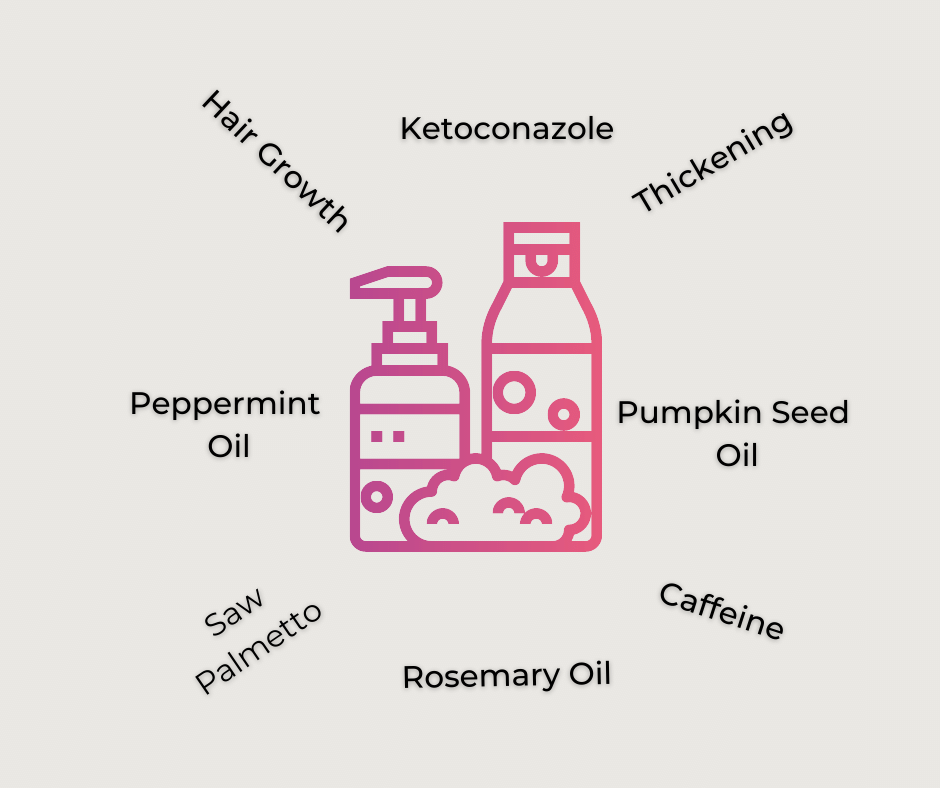
When experiencing hair loss or thinning hair, finding a hair regrowth shampoo that works can be a struggle. There’s an endless number of shampoos boasting all sorts of claims about curing thin hair, with very little or no evidence to support their claims. Trying one shampoo after another can not only be expensive but also leave you sceptical about the benefits of using a dedicated hair growth shampoo.
Male Pattern Baldness
Thinning hair or hair loss in men is usually the result of male-pattern baldness. It’s a genetic condition that will affect up to 85% of men at some stage in their lives.
In male-pattern baldness, the hormone DHT directly affects the hair follicle and is responsible for causing the follicle to shrink over time. As the follicle gets smaller, the diameter of the hair growing out of the follicle also gets smaller, resulting in finer, thinner hair. Eventually, hair stops growing out of the follicle resulting in sparse or bald patches on the scalp.
While the most effective treatments for male pattern baldness involve using prescription medicine to open up the hair follicle and regrow hair, adding a medicated shampoo to your routine can complement your prescribed treatment and increase your regrowth.
However, picking the best shampoo to treat hair loss or thinning hair can be difficult. Understanding the active ingredients and the science behind them is your best way in selecting a shampoo that works.
You also need to understand what hair thickening shampoos are and how they differ from a shampoo that stimulates real growth.
Hair Thickening Shampoos
Hair thickening shampoos work by giving the illusion of thicker hair. They coat the hair with a protein and vitamin (panthenol – vitamin B5) or a polymer to wick in moisture for added width. They also reduce the amount of space between the hair strands to give the scalp a “fuller” appearance. Additional ingredients will be added to provide moisturising effects and attractive scents, but the protein and the panthenol give the illusion of thickness.
While this may sound great, the effects are temporary, and the thickening layers only stay on until your next shower. If you switch to using a regular shampoo, they’re designed to strip the chemicals and impurities out of your hair. The result is that they’ll strip the thickening agents that are coating your hair, and your hair will return to its former thin state. This means that you’ll need to continue using hair thickening shampoo for as long as you want to make your hair appear thicker.
In summary, thickening shampoos make the hair appear thicker, but they’re not making any changes to the hair thickness itself.
Hair Growth Shampoos
A hair growth shampoo should contain active ingredients that impact the hair follicle or growth rate of the hair.
Many shampoos include natural ingredients such as biotin, niacin, vitamin B6, tea tree oil, lactic acid, keratin, vitamin E, argan oil, apple cider vinegar, all promising excellent results. These ingredients are important for strong and healthy hair, but unfortunately, they don’t help reduce hair loss or increase hair growth.
We’ve created a list of the active ingredients commonly promoted in hair growth shampoos so you can make an informed decision when making a purchase.
Ketoconazole
Ketoconazole is an antifungal drug licensed to treat certain skin conditions, including dandruff. While ketoconazole shampoo (Nizoral) is not approved to treat hair loss, it’s often prescribed off label as a hair loss treatment for male pattern baldness.
It’s thought that ketoconazole has anti-inflammatory properties on the scalp and also disrupts the DHT pathway.
A study in 1998 compared the use of ketoconazole shampoo with an unmedicated shampoo in conjunction with or without Minoxidil 2%. The results indicated that ketoconazole positively affected hair density and the proportion of hair follicles in the growth phase.
A review in 2020 of all published literature demonstrated that ketoconazole increased hair regrowth and hair shaft diameter compared to control groups. It concluded that ketoconazole is a promising adjunct or alternative therapy in the treatment of male pattern baldness.
Whilst these studies show promise, it’s important to understand that ketoconazole is not the silver bullet to treat your hair loss. Think of it as part of the solution.
Saw Palmetto
Saw Palmetto is a herbal supplement derived from the plant Serenoa Repens. It has small berries and has been used by Native Americans as medicine and food for hundreds of years. There’s evidence that an extract of saw palmetto berries may block the conversion of testosterone to DHT, giving hope to those suffering from enlarged prostate or hair loss.
Research on whether saw palmetto works to treat hair loss is limited but promising.
A 2012 Study looked at the use of oral saw palmetto in comparison with a commonly prescribed DHT blocker taken every day for 24 months. Results showed an increase in hair growth in 38% of patients using saw palmetto.
A 2014 study evaluating the effectiveness of a topical saw palmetto combination applied to the scalp showed an increase in total hair count of 11.9% and an increase in the proportion of hair in the growth phase.
A slightly larger study in 2015 containing 50 participants showed an increase in hair count at weeks 12 and 24 compared to baseline when using topical saw palmetto.
As with ketoconazole, saw palmetto may benefit your prescription treatment plan as an add-on therapy. It may also be an alternative if you can’t tolerate prescription DHT blockers.
Other Ingredients
Rosemary Oil
Rosemary oil is an essential oil with health uses ranging from antioxidant and anti-inflammatory benefits to memory enhancement.
In recent years it’s been proposed that rosemary oil may provide benefit in hair growth. A 2015 study compared rosemary oil to minoxidil 2% on humans with male pattern baldness. Results showed that rosemary oil was just as effective as minoxidil 2%, with both groups showing a similar increase in hair count at six months.
Pumpkin Seed Oil
Several studies have been conducted on the use of pumpkin seed oil for hair growth. As the name suggests, the oil is extracted from pumpkin seeds.
A 2014 study on men with male pattern baldness compared the effect of pumpkin seed oil (PSO) 400mg taken daily with a placebo for 24 weeks. The results showed that those who took the PSO supplements experienced 30% more hair growth than those that received the placebo. It must be noted that the pumpkin seed was not tested alone, it contained other ingredients, and the study was relatively small.
A recent study in 2021 looked at topical pumpkin seed oil applied to the scalp compared to topical minoxidil 5% foam for three months. Pumpkin seed oil was comparable to minoxidil 5%, with a significant increase in new hair.
It’s thought that pumpkin seed oil may have the ability to disrupt the DHT pathway and have a positive effect on hair growth.
Caffeine
There’s been a bit of contention recently about the effectiveness of caffeine on hair growth. In 2018, the UK Advertising Standards Authority ruled that caffeine shampoo Alpecin must no longer advertise that it can “help reduce hair loss” as there was no adequate evidence to support the claim.
While there have been lab-based studies in 2007 and 2014 which give encouraging data on caffeine and hair growth, more extensive human studies are required to draw a definitive conclusion.
It‘s known that the caffeine molecule penetrates easily into hair follicles. Still, it remains unclear whether a shampoo can deliver a sufficient concentration of caffeine to maximise its potential benefits. The growth-enhancing effects of caffeine are likely to be greater with a leave-in topical solution.
A 2017 study compared a 0.2% caffeine solution with a minoxidil 5% solution over six months. The study showed that the caffeine solution was comparable in effectiveness to minoxidil when measuring the increased hair in the growth phase.
Peppermint Oil
Peppermint oil is used in shampoos, cleansers, bath products, makeup, and lotions. However, a study published in 2014 suggests the benefits of peppermint oil may go beyond cosmetics.
Peppermint oil 3% was applied over four weeks and compared to other topical applications (saline, jojoba oil, and minoxidil 3%). The peppermint oil group showed the most prominent hair growth effects, suggesting it rapidly induces the hair growth stage in the follicle. However, this study was conducted on mice.
Peppermint naturally contains menthol. A 2016 study looked at the effects of menthol on blood flow to the skin. The study found that a menthol solution caused blood vessels to widen, which increased blood flow. Though not linked to hair growth, in theory, the increased blood flow could encourage more hair to grow in the affected area.
Summary
When you select a shampoo to complement your hair loss treatment plan, it’s fair to say you won’t get one shampoo with every active ingredient listed above. Select one with a couple of the ingredients supported by science, and you will be on the right track.
Also, remember that you should combine the shampoo with a clinically proven prescription treatment plan to maximise your chances of regrowth. The shampoo alone just won’t cut it.
For more information about this article or other hair loss queries, get in touch with a qualified consultant.
Email: [email protected]
SMS: 0480 006 048
Or book in for a quick chat over the phone at a time that suits you.

